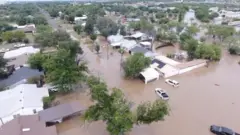Texas Floods: Unanswered Questions on Early Warnings Amidst Devastating Flash Floods
Texas Floods: Unanswered Questions on Early Warnings Amidst Devastating Deluge
Central Texas is grappling with the aftermath of catastrophic flash floods that have claimed the lives of nearly 80 individuals, with officials cautioning that the final death toll may be even higher. The relentless deluge, which saw rainfall equivalent to several months in mere hours, overwhelmed communities, particularly in Kerr County, where a tragic incident at a girls’ camp resulted in the deaths of 28 children. This disaster has ignited a crucial debate surrounding the effectiveness and timeliness of flood warnings issued to the public.

The extent of the flooding caught many by surprise. Kerr County Judge Rob Kelly stated that there was “no reason to believe that this was gonna be any, anything like what’s happened here. None whatsoever.” This sentiment underscores a broader concern about the unexpected ferocity of the storm, which caused the Guadalupe River to rise an astonishing 26 feet in just 45 minutes, breaching its banks and inundating surrounding areas.
Timeline of Warnings and Preparedness
The events leading up to the disaster reveal a series of official actions and, perhaps, missed opportunities. The Texas Division of Emergency Management (TDEM) had activated state emergency response resources on Wednesday due to “increased threats of flooding.” Subsequently, the National Weather Service (NWS) issued a Flood Watch for Kerr County on Thursday afternoon, identifying it as an area at high risk for overnight flash flooding. However, a specific Flash Flood Warning for Kerr County was not issued until 01:14 local time on Friday, with a subsequent emergency flash flood warning for the area and the Guadalupe River following at 04:03 and 05:34 respectively.
Questions have also been raised regarding local preparedness measures. Judge Kelly noted that Kerr County does not have a county-administered flood warning system, such as a siren, due to the significant costs involved. He recalled that approximately six years prior, the county had explored implementing such a system, but it was never realized.
Official Responses and NWS Defenses
Texas Governor Greg Abbott emphasized that Texans are accustomed to flood warnings but acknowledged that “there’s no expectation of a water wall of almost 30ft high.” Similarly, Nim Kidd, chief of the Texas Division of Emergency Management, pointed to challenges such as areas with intermittent or no cell phone coverage, which could hinder even the most robust alert systems.
Kerrville City Manager Dalton Rice, speaking to the Associated Press, suggested that the public can become desensitized to frequent weather warnings. He recounted his personal experience of a seemingly calm morning jog along the Guadalupe River trail just hours before the waters surged dramatically.
The NWS, in response to the events, expressed deep sorrow for the loss of life and defended its actions. The agency stated that its Austin/San Antonio office provided forecast briefings and issued a Flood Watch on July 3rd, followed by Flash Flood Warnings that offered “preliminary lead times of more than three hours before warning criteria were met.” Some former NWS officials, speaking to The New York Times, indicated that the forecasts were as accurate as possible given the storm’s rapid intensification and the sheer volume of rainfall.
Concerns Over Staffing and Budget Cuts
Adding another layer to the discussion are concerns about the potential impact of budget cuts on the National Weather Service (NWS) and its parent agency, the National Oceanic and Atmospheric Administration (NOAA). Reports suggested that budget reductions, including those affecting weather research laboratories and employee numbers, might have affected the agency’s capabilities. Meteorologists have voiced concerns about a potential reduction in the number of weather balloons used for crucial atmospheric observations, which could impact forecasting accuracy.
The New York Times reported that vacant critical positions within the NWS on the morning of the tragedy raised questions about whether staffing shortages impeded coordination with local emergency managers. However, Tom Fahy, legislative director of the NWS Employees Organization, asserted that the weather forecasting offices “had adequate staffing and resources as they issued timely forecasts and warnings leading up to the storm.” Furthermore, Jason Runyen, an NWS meteorologist, mentioned that their office, responsible for the affected central Texas region, actually had more staff on duty than usual during the storms.
Government Response and Future Preparedness
US Homeland Security Secretary Kristi Noem addressed the tragedy, acknowledging the inherent difficulty in predicting weather patterns while highlighting President Trump’s commitment to modernizing the existing warning systems. She assured that concerns about NWS budget impacts would be conveyed back to the federal government, emphasizing that while the NWS has historically performed well, there is a universal desire for improved warning times. Secretary Noem stated that the Trump administration is prioritizing the upgrade of long-neglected technologies used for issuing warnings, with ongoing reforms aimed at enhancing the system’s capabilities.
President Trump is reportedly considering a visit to the disaster-stricken area, signaling the federal government’s attention to the crisis and its commitment to addressing future preparedness challenges.



Post Comment